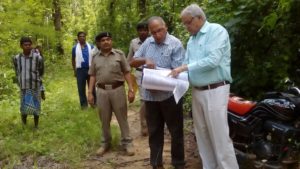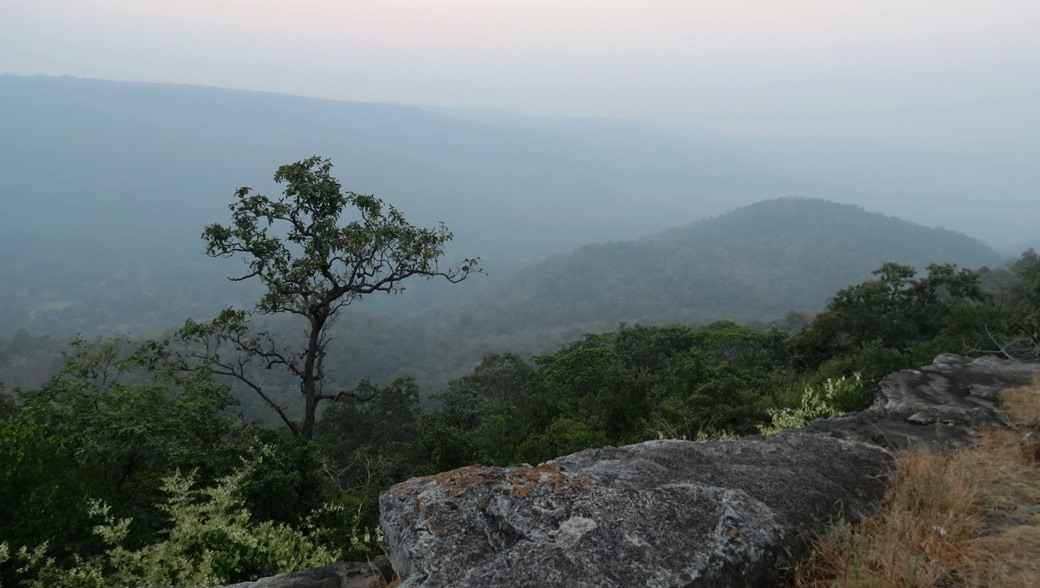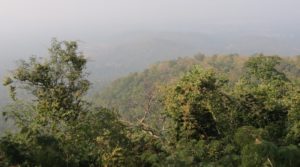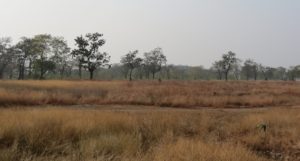The Chhattisgarh State Action Plan for Climate Change (CSAPCC), with its motto of “Inclusive Growth for Improved Resilience” aims at (a) mainstreaming of climate concerns into all aspects of development policy and implementation, and (b) ensuring complementarity with and contributing to the national agenda on climate change.
Ensuring complementarity with the national agenda on climate change and contributing to it has assumed high importance after the Paris Agreement since India has decided to create, subject to centrality of adaptation to the changing climate, an additional carbon sink of 2.5 to 3 billion tons of carbon dioxide by 2030. In addition installation of 5 GW of biomass based power generation by 2023 is also planned under renewable energy.

Dr. Promode Kant (2nd from right) with Forest Dept. Staff of Chhattisgarh in Medicinal Plant Conservation Areas in Dhamtrari, Chhattisgarh
Adaptation in ecosystems should address the core problems of poor regeneration, forest fires, pest and disease, weed infestation, loss of top soil and poor soil moisture retention, lowered productivity, and encroachment of wetlands and resulting pollution, while also increasing opportunities for higher sequestration and, equally importantly, far higher emphasis on rural job creation.
Adaptation to changing climate is best possible in younger trees that ensure greater resistance to diseases and pest attacks and lower vulnerability to fires. This adaptation approach over nearly 1.7 million hectares of open, 3.74 million hectares of medium density, and 0.4 million hectares of dense forests in the state would involve reduced rotation and increased, but sustainable, harvesting for encouraging younger and more resilient forest crop, intensive fire prevention, pest and disease management, weed management, gap seeding and planting, non-consumptive use of forests, high levels of technological and managerial investments in NTFP resources among others.
Second Generation JFM
Currently activities under JFM are low intensity and basically designed to provide only supplemental sustenance to the forest dependent people and is unable to cope with scaled up and intense forestry activities as would be required to achieve the post-Paris targets in the forestry sector. It is for this reason that an intensely scaled up version of Joint Forest Management, which is best called the Second Generation Joint Forest Management, is proposed below.
Sustained high investments in these activities would create very high levels of forestry based employment among the forest dependent communities. According to an FAO estimate annual investment of $1 million in these activities creates 500 to 1000 round the year jobs in developing countries. This would also mean a sharp upsurge in the requirement of technically skilled supervisory forestry staff for 5-6 months every year stationed in the remotest parts of the state which would be met by recruitment from local communities, trained intensively and appointed as Community Forest Officers (CFO) in the rank of Forester and Forest Guard, parallel to the Special Police Officers in some states.
They would have the powers of a forest officer under the Indian Forest Act, entitled to forest uniform, and get paid at levels similar to the regular forest officials for the duration of work. In addition, there would be Community Forest Workers placed in the category of skilled workers, and paid same wages, after training them in forestry activities.
No Community Forest Officer shall work for forest department more than 6 months in a calendar year in the forest department and would be expected to work and reside within the community for the rest of the year. A department Code setting standards for the daily work expected from the CFOs shall be drawn up and enforced strictly. At least one third of the Community Forest Officers shall be women. This large scale well paid participation in forest department activities would also serve to reduce the distance between the government and the people in the left wing extremism affected areas.
Some concrete tasks that can be taken immediately for adaptation to climate change through the Community Forest Officers are:
1. Keeping forest crops young and vigorous
Reducing harvesting age of Sal trees from the present 100 years to 70 years would result in more vigorous forests that are less vulnerable to Sal borer attack and other pests and diseases without affecting the market value of the harvested wood significantly.
This will also enable increased production of wood, faster carbon sequestration besides generating more employment to the local people.
Under very intensive forest management envisaged it would require the services of one Community Forester, two Community Forest Guards, and six skilled Community Forest Workers for the enhanced marking and other harvesting related tasks for every 5000 ha throughout the year in all forest areas except sanctuaries and national parks.
2. Continuous forest crop care through thinning
Intensive thinning is needed in most forests including very dense including hygienic thinning. All pending mechanical and silvicultural thinning operations should be completed within two years period. Marking of trees for thinning should be viewed as a highly technical task with a code that should be strictly followed by field executives and closely monitored by senior officers.
It would require the additional services of one Community Forester, two Community Forest Guards and six skilled Community Forest Workers for the enhanced marking and other thinning related tasks for every 5000 ha throughout the year in all forest areas except sanctuaries and national parks.
3. Weed control
Weeds are already a moderate to severe problem in the forests of the state seriously affecting regeneration and productivity and the problem is likely to worsen with changing climate that creates suboptimal environment for the existing forest crops.
An intensive program of weed removal and replacement with ecologically and economically appropriate species needs to be taken up across the state. Tall and hardened saplings of two meter height and above would need to be planted to enable suppression of weed regrowth.
This would necessitate the additional services of one Community Forester, two Community Forest Guards and 6 skilled Community Forest Workers for weed control related tasks for every 1000 ha for three months in a year in all open forests and half of the moderate density forests but is not needed in very dense forests.
4. Increasing forest density in open and medium density forests
Almost two third of open forests in the state and one third of medium density forests need special efforts to increase their density by assisted natural regeneration and skillful silvicultural manipulations combined with gap planting by 2 meter tall and hardened saplings, sometimes even transplantation of young trees. In some places, seeding may also work satisfactorily.
This would necessitate the additional services of one Community Forester, two Community Forest Guards and six skilled Community Forest Workers for assisted regeneration and gap planting related tasks for every 1000 ha for three pre-monsoon months in a year in identified parts of open and medium density forests.
5. Intensive soil and moisture conservation measures
The current trends towards lower precipitation and higher temperatures require urgent and massive steps to reduce surface runoff and increasing soil moisture for increasing productivity. A wide range of locally suited soil moisture conservation measures should be adopted including stone and vegetative check-dams and contour trenches on steep and exposed slopes along with tree planting. Mulching top soil around young plants and on severely exposed sites should also become an important part of these measures.
These are already in practice in watershed areas but now investment in soil and moisture conservation measures would have to be significantly higher. About 20% of the open forest areas needs this treatment requiring the services of 1 Community Forester, 2 Community Forest Guards and 6 skilled Community Forest Workers for every 1000 ha of the identified areas for three months during winter and spring every year.
6. Reducing damage by forest fires
Fire information system is technologically quite advanced but both the field response mechanism and preventive measures require massive investment. The Working Plan Manual prescribes three tier classification for fire protection with the highest protection laying emphasis on fire prevention being essentially confined to the First Class forests. This highest degree of fire protection may now be provided to all of forests subject to financial and technical feasibility.
Most of the existing fire lines are also overgrown with vegetation and require re-clearance. In some localities removal, including cautious pre-burning, of fallen leaves and woody debris is also required and, in specific localities, where grazing and NTFP collection is the primary reason of fires, fire watchers may be needed.
Overall this would require the services of one Community Forester, two Community Forest Guards and six skilled Community Forest Workers for every 1000 ha of all forest areas for three months during spring and early summer every year.
7. Non-timber forest products
Most of the state forests are rich in NTFP but do not generate adequate incomes for the local collectors. The highest value of these products lies in their genuineness which, when ensured and communicated effectively to the consumers through internet marketing facilitated by the forest department, has the potential of bringing very high rise in incomes. Nature cure based ecotourism could also be built around it. Planting of desirable species at intensive scale would be needed in several areas. This would require the services of a Community Forester trained in modern techniques of marketing for each range for six post-monsoon months every year who should be placed under the direct guidance of a brilliant young officer of the Indian Forest Service.
8. Agroforestry, urban and peri-urban forestry
Agricultural lands of low productivity, and all available urban and peri-urban lands should be encouraged to be brought under tree planting. Since these serve an important public cause even when on private lands the existing schemes for these activities should be made locally more attractive by Panchayat level innovations encouraged and supported by state government. This would require the services of one Community Forester trained in agroforestry for each range for four months during agriculture season every year.
9. Tree nurseries
For the massive reforestation and afforestation programs mentioned above, often requiring two meter tall hardened saplings, a large number of permanent and semi-permanent nurseries would be needed in all JFM Committees each of which shall be maintained by two Community Forest Workers recruited exclusively from among the local women duly trained by the forest department in nursery activities. One lady Community Forest Guard would supervise the work of four such nurseries.
Financing this enormous increase in activities and staff
The nature, scale and intensity of the suggested activities, and the manner of their execution through neighbouring communities and CFOs, would result in rise in annual plan expenditure by several multiples over its current levels. This should be possible as these activities are expected to bring substantial financing and easier access to the best technologies and management skills and, therefore, presents excellent opportunities of causing deep and foundational changes in the ways forest governance and management is carried out in the state in the interest of not only the forests as ecosystems but also of forest dependent communities.
The Green Climate Fund (GCF) is the lead Fund now for climate related finance both in the pre-2020 (before the implementation of Paris Agreement actually begins) and post-2020 phases and is expected to mobilize $100 billion annually for climate change mitigation and adaptation and leverage a far larger share of private finance mostly in mitigation linked activities. The GCF provides an excellent platform for financing of forestry activities of the kind envisaged in this Policy Note.
As the implementation of the provisions of the Paris Agreement gathers pace over the coming years it is reasonable to expect that there would not be dearth of money for well-designed forestry projects. But since processes involved in obtaining external financing takes a minimum of one year at the very least it is important to access available domestic funding. CAMPA finance is one such possible source on account of both its operability outside the normal state budget, and a degree of commonality between approved CAMPA activities and activities suggested above in this Policy Note.
Kanker Pilot for Climate Change Adaptation through Second Generation JFM
Implementation of the changes proposed in this CSCCAP review may be carried out in only one district since the cost consequences of intensive adaptation activities are very high. It would be advisable to implement the concept of Second Generation JFM on a pilot scale over a large tribal district in the state which has both insurgency affected and unaffected areas like the Kanker district. The district of Kanker is proposed which has 21500 ha of very dense forests, 203800 ha of moderately dense forests and 82400 ha of open forests, where joint forest management is already reasonably well developed, and which has both insurgency free and insurgency affected areas. In the beginning forest areas unaffected by insurgency could be taken up, and once the concept is found highly attractive by the inhabitants on a large scale it would be possible to extend it to the insurgency affected areas, too, inspite of the expected opposition from the insurgents.
- Keeping forest crops young and vigorous: 1 Community Forester, 2 Community Forest Guards and 6 skilled Community Forest Workers for every 5000 ha throughout the year in all forest areas except PA (20%). 49 Com For, 98 Com FG, 295 Com FW throughout the year;
- Continuous forest crop care through thinning: 1 Community Forester, 2 Community Forest Guards and 6 skilled Community Forest Workers for every 5000 ha throughout the year in all forest areas except PAs (20%). 49 Com For, 98 Com FG, 295 Com FW throughout the year;
- Weed control: 1 Community Forester, 2 Community Forest Guards and 6 skilled Community Forest Workers for every 1000 ha for 3 months in a year in all open forests and half of the moderate density forests. 184 Com For, 368 Com FG, 1104 Com FW for 3 months every year;
- Increasing forest density in open and medium density forests: 1 Community Forester, 2 Community Forest Guards and 6 skilled Community Forest Workers for three months in a year over two third of open forests and one third of medium density forests. 124 Com For, 248 Com FG, 744 Com FW for 3 months every year;
- Intensive soil and moisture conservation: 1 Community Forester, 2 Community Forest Guards and 6 skilled Community Forest Workers for every 1000 ha for three months in a year over 20% of open forests. 16 Com For, 32 Com FG, 96 Com FW for 3 months every year;
- Reducing damage by forest fires: 1 Community Forester, 2 Community Forest Guards and 6 skilled Community Forest Workers for every 1000 ha of all forest areas for three months in a year. 307 Com For, 614 Com FG, 1842 Com FW for 3 months every year;
- Non-timber forest products: 1 Community Forester for each range for six months in a year. 20 Com For for 6 months in a year for twenty ranges;
- Agroforestry, urban and peri-urban forestry: 1 Community Forester for each range for four months every year. 20 Com For for 4 months in a year for twenty ranges;
- Tree nurseries: 2 Community Forest Workers for each JFM, 1 Community Forest Guard for 4 JFM throughout the year. 227 Com FG and 1820 Com FW throughout the year for 910 JFM.
Total requirement of CFOs for the Pilot Project
This totals up to 273 Community Foresters, 739 Community Forest Guards and 3510 Community Forest Watchers on an annual basis. At the annual compensation of Rs 250000 for Forester and Rs 200000 for Forest Guard and Rs 252 per day for skilled workers, the total amount needed for payment to these community officials in Kanker district in one year would be 54 crores. With a 20% overhead and contingent amount for transport, equipment, shelters, health and insurance etc the annual budget for this Kanker Pilot for Second Generation Joint Forest Management would amount to Rs 65 crores.
All photos are by G. Dhanapal of WRI India. Featured photo is a view of Sitandi Ullandi Tiger Reserve in Chhattisgarh from a hill top.
About the Author
 Dr. Promode Kant holds a PhD in Climate Change and Forestry, Masters in Physics and in Forestry, post graduate diploma in wildlife management, and has more than three decade long experience in the Indian Forest Service related to tropical forest management, forest-tribe interface, shifting cultivation, climate change mitigation and adaptation, international environmental conventions, Protected Area management, coastal zone and wetland conservation among others. He has been a Visiting Professor at the Faculty of Forest Sciences, University of Eastern Finland, from 2005 till 2009 and is a frequent visiting faculty at the Indian Institute of Management at Bangalore, Indira Gandhi National Forest Academy, Dehradun, and at the Institute of Forest Policy and Information of the Chinese Academy of Forestry, Beijing.
Dr. Promode Kant holds a PhD in Climate Change and Forestry, Masters in Physics and in Forestry, post graduate diploma in wildlife management, and has more than three decade long experience in the Indian Forest Service related to tropical forest management, forest-tribe interface, shifting cultivation, climate change mitigation and adaptation, international environmental conventions, Protected Area management, coastal zone and wetland conservation among others. He has been a Visiting Professor at the Faculty of Forest Sciences, University of Eastern Finland, from 2005 till 2009 and is a frequent visiting faculty at the Indian Institute of Management at Bangalore, Indira Gandhi National Forest Academy, Dehradun, and at the Institute of Forest Policy and Information of the Chinese Academy of Forestry, Beijing.
Since 2002 Dr Kant has been involved in writing, teaching and capacity building in climate change adaptation, on Reducing Emissions from Deforestation and Forest Degradation (REDD+) and has advised government on, among other things, cases involving violations of tribal rights and in dealing with the left wing extremism among the forest based communities in central India. He has worked on the sustainability of agro-pastoral practices of nomadic people of western Rajasthan in India and has written more than four dozen papers on forestry and climate change related issues and has been a co-author of a number of books. He is a reviewer of the Elsevier Journal of Energy Policy and of Elsevier Journal of Forest Policy and Economics besides many other national and international journals.




